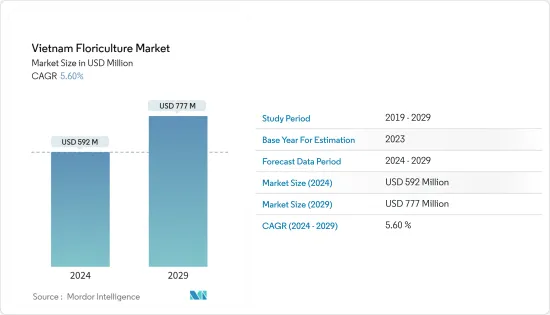PUBLISHER: Mordor Intelligence | PRODUCT CODE: 1536794

PUBLISHER: Mordor Intelligence | PRODUCT CODE: 1536794
Vietnam Floriculture - Market Share Analysis, Industry Trends & Statistics, Growth Forecasts (2024 - 2029)
The Vietnam Floriculture Market size is estimated at USD 592 million in 2024, and is expected to reach USD 777 million by 2029, growing at a CAGR of 5.60% during the forecast period (2024-2029).

A diverse climate, featuring a subtropical north and a tropical south, creates optimal conditions for growing various flowers. Regions like Da Lat and the Mekong Delta, with their fertile soils and favorable temperatures, support the cultivation of roses, chrysanthemums, orchids, and lilies, establishing Vietnam as a significant player in the global floriculture market. While traditional flowers such as orchids and lilies remain popular, consumer preferences are shifting toward imported varieties like roses, carnations, and tulips, especially for special occasions. Therefore, the government in the country is promoting domestic flower production through its incentive policy, which offers training, market development support, financial incentives, and subsidies to enhance productivity with new technology in the floriculture sector. Apart from this, various initiatives by players are anticipated to drive the market's growth. For instance, in February 2023, Dalat Hasfarm celebrated the grand opening of two new premium fresh flower stores in Ho Chi Minh City and Hanoi, marking a significant milestone in the expansion of its modern retail flower store chain.
Floriculture in Vietnam Market Trends
Conducive Climatic Conditions Favoring Production and Export
Vietnam has a diverse climate, including subtropical, tropical, and temperate zones, influenced by tropical monsoons and a range of altitudes and latitudes. This diversity allows year-round cultivation of various flowers to meet different market needs. Lam Dong province is a prime tropical and temperate flower cultivation location. Its optimal day-night temperatures and ample flat land make it a golden spot for large-scale flower production, attracting significant investment and expertise in horticulture. The landscape is tailor-made for extensive cut flower production, with several river deltas featuring fertile alluvial soil. Notably, the Red River Delta and Mekong Delta offer the best prospects for scaling up production, providing ideal conditions for high-quality flower growth.
Rose Is A Favorable Choice Among Vietnamese
The rose is the most popular flower in Vietnam. The major production areas are concentrated in big cities such as Hanoi, Ho Chi Minh City, Hai Phong, and Dalat. The area under rose cultivation expanded significantly during recent years and is likely to increase further in the coming years. Roses can be planted and harvested annually in the Red River Delta, Dalat, Ho Chi Minh City, and other provinces. The popular varieties of roses grown in Vietnam are the white and red roses in Quang, light yellow, light pink, dark yellow, dark red in Dalat, black red, and creeping roses in other places. The White Stacked Rose or Nam Dinh Ancient rose variety is grown conventionally in the country. Hong Kong, Japan, Thailand, Singapore, and China are top destinations for the export of roses from Vietnam.
Additional Benefits:
- The market estimate (ME) sheet in Excel format
- 3 months of analyst support
TABLE OF CONTENTS
1 INTRODUCTION
- 1.1 Study Assumptions and Market Definition
- 1.2 Scope of the Study
2 RESEARCH METHODOLOGY
3 EXECUTIVE SUMMARY
4 MARKET DYNAMICS
- 4.1 Market Overview
- 4.2 Market Drivers
- 4.2.1 Favorable Climatic Conditions
- 4.2.2 Blooming Export Opportunities
- 4.3 Market Restraints
- 4.3.1 High Adoption Cost of Modern Technology
- 4.3.2 Increasing Insect Infestations
- 4.4 Porter's Five Forces Analysis
- 4.4.1 Bargaining Power of Suppliers
- 4.4.2 Bargaining Power of Buyers/Consumers
- 4.4.3 Threat of New Entrants
- 4.4.4 Threat of Substitute Products
- 4.4.5 Intensity of Competitive Rivalry
- 4.5 Country Profiles
- 4.5.1 Business Opportunities
- 4.5.2 PESTLE Analysis
5 MARKET SEGMENTATION
- 5.1 Flowers Type
- 5.1.1 Rose
- 5.1.2 Chrysanthemum
- 5.1.3 Orchid
- 5.1.4 Carnation
- 5.1.5 Lilies
6 VALUE CHAIN AND TRADE ANALYSIS
- 6.1 Value Chain Analysis
- 6.2 Distribution Channel Analysis
- 6.3 Trade Analysis
- 6.3.1 Import Analysis
- 6.3.2 Export Analysis
7 MARKET OPPORTUNITIES AND FUTURE TRENDS




